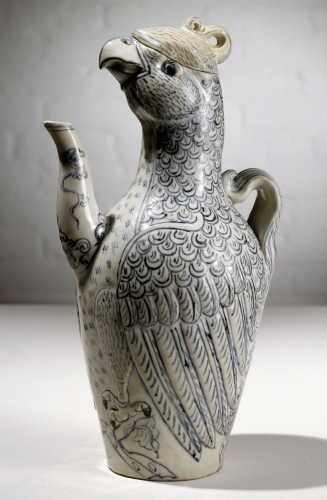Art in Everyday Continued
My abhorrence of the term “craft” has led me to make April “non-craft month.” I aim to show how there is art in everyday life. I started out two weeks ago with the beautiful work of James Prestini. I now wander into the realm in which the artists may not be known, but the objects they’ve created are works of art nonetheless.
 |
| Copco (firm founded 1960), Bella Tea Kettle, ca. 2003. Porcelain enamel on steel. Private collection. |
I begin with a teapot my mother bought me (because she left the previous one on the stove and melted the ceramic off the bottom, but I digress). It is an elegant example of art in everyday life. I became fascinated with this idea (for the millionth time) the weekend of the 31st of March, while viewing a skateboarding competition. (Those folks are amazing: the way they elegantly float in the air. Such an art form!) I chose the tea kettle because it is a universal type of vessel used for pouring.
I present you some others:
 |
| China, Shang Dynasty (ca. 1523–1028 BCE), Ewer (kuei), ca. 1400 BCE. Bronze. © Spencer Museum of Art, University of Kansas, Lawrence. (SMA-75) |
The Bronze Age in China (ca. 2000–200 BCE) produced a large variety of vessels all with intricate incised and raised decoration. The kuei was originally a vessel of earthenware used to store wine or oil for the tomb, which later changed to bronze and was primarily used for ceremonial or symbolic purposes. During the mid to late Shang period, bronze vessels were symbols of status, power, and prestige. Some emperors used nine or ten kueis in a single ceremony while honoring ancestors.
This is an example of a tripod vessel, which means it has three legs. On each corner of this triangular vessel is a raised taotie pattern. The taotie is an animal or dragon face that is split so that it is presented as two frontal views. Elaborate scroll work usually accompanies the design. Chinese bronze were produced from sectional molds built around a model. The interior of the molds bore the incised or raised decoration. The space between the mold and the model took the molten bronze to form the vessel.
 |
| Germany, Aquamanile (saddled horse), ca. 1300. Bronze, 9" x 18 7/8" (23 x 48 cm). © Cleveland Museum of Art. (CL-300) |
The Aquamanile derives from ancient Roman times. Aqua means water in Latin and manile comes from manus for hands. The vessel was used at dinner tables for guests to wash their hands between courses. The tradition continued in Europe during the Middle Ages (ca. 1000–1400), among the upper classes, particularly in Germany (German rulers considered themselves descendants of the Roman Empire (ca. 27 BCE–535 CE). The vessel has a hinged lid on the horse’s forelock, and the water spout is the mouth. This horse is most likely a secular object. The aquamanile also evolved into a liturgical object in the medieval church. The vessel was used during the mass for washing the priest’s hands.
 |
| Vietnam, Parrot-form Ewer, 1500s. Porcelain, 11 ¼" x 13" x 12 1/8" (28.5 x 33 x 30.8 cm). © Worcester Art Museum, Worcester, MA. (WAM-537) |
Although China dominated ceramic styles in Asia and Southeast Asia for centuries, Vietnam managed to develop its own distinctive styles. Ceramics kilns date back 2000 years, but the oldest persistent style dates to the 11th through the 15th centuries. It consisted of incised, iron (brown) glazed decoration on stoneware. Such wares were exported as far as the Philippines and Indonesia. Starting in the southern Song dynasty in China (1127–1279) there was extensive export of porcelain to other parts of Asia, and hence an increase in Chinese influence in Vietnamese wares. Porcelain became a strong export item for Vietnam starting in the 14th century. Like Chinese porcelain of the time, many Vietnamese wares have a cobalt blue underpainted design (which sometimes appears charcoal grey). This ewer is comparable to Korean examples from the same period.
 |
| Earl S. Tupper (1907–1983, US) (designer), Pitcher and Creamer, 1946. Polyethylene pitcher height: 6 ½" (16.5 cm), creamer height: 4 ¼" (10.8 cm). Photo © The Museum of Modern Art, New York. Gift of the manufacturer. (MOMA-D0830) |
Earl Tupper formed the Earl S. Tupper Company in 1938 to design and engineer industrial plastics. He garnered several military contracts during World War II. After the war, Tupper turned his attention to plastic products for the consumer market. In the 1940s, plastic was still in its infancy. The commercial market for plastic products was limited by the common perception that plastic (a petroleum-based product) was smelly, greasy, and brittle. Tupper developed a method for purifying polyethylene slag, a waste produced by oil refinement, into a plastic that was flexible, tough, non-porous, non-greasy, and translucent. Then he developed an airtight lid based on the design of paint can lids. Together these innovations were the foundation for Tupperware. Retail sales of Tupperware initially failed, apparently because the new lid needed demonstration. Based on the Stanley Home Products model of house parties, the Tupperware party was born and remains to this day the exclusive outlet for Tupperware.
Correlations to Davis programs: Explorations in Art Grade 2: 3.17-18 studio; Explorations in Art Grade 4: 4.24, 23-24 studio; Explorations in Art Grade 6: 4.22, 4.21-22 studio

Comments